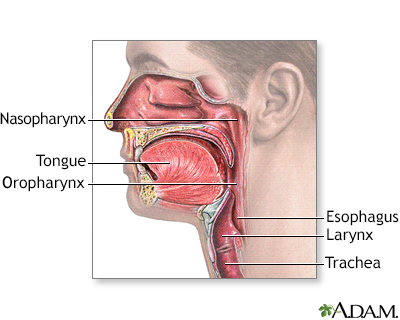Pregnancy SmartSiteTM
Submandibular space infection; Sublingual space infection; Ludwig's angina DefinitionLudwig angina is an infection of the floor of the mouth under the tongue. It is often due to a bacterial infection of the teeth or jaw. CausesLudwig angina is a type of bacterial infection that occurs in the floor of the mouth, under the tongue. It often develops after an infection of the roots of the teeth (such as tooth abscess) or a mouth injury. This condition is uncommon in children. SymptomsThe infected area swells quickly. This may block the airway or prevent you from swallowing saliva. Symptoms include:
Other symptoms that may occur with this disease:
Exams and TestsYour health care provider will do an exam of your neck and head to look for redness and swelling of the upper neck, under the chin. The swelling may reach to the floor of the mouth. Your tongue may be swollen or pushed up to the top of your mouth. You may need a CT scan. A sample of the fluid from the tissue may be sent to the lab to test for bacteria. TreatmentIf the swelling blocks the airway, you need to get emergency medical help right away. A breathing tube may needed to be placed through your mouth or nose and into the lungs to restore breathing. You may need to have surgery called a tracheostomy that creates an opening through the neck into the windpipe. Antibiotics are given to fight the infection. They are most often given through a vein until symptoms go away. Antibiotics taken by mouth may be continued until tests show that the bacteria have gone away. Dental treatment may be needed for tooth infections that cause Ludwig angina. Surgery may be needed to drain fluids that are causing the swelling. Outlook (Prognosis)Ludwig angina can be life threatening. It can be cured with getting treatment to keep the airways open and taking antibiotic medicine. Possible ComplicationsComplications may include:
When to Contact a Medical ProfessionalBreathing difficulty is an emergency situation. Go to the emergency room or contact your local emergency number (such as 911) right away. Contact your provider if you have symptoms of this condition, or if symptoms do not get better after treatment. PreventionVisit the dentist for regular checkups. Treat symptoms of mouth or tooth infection right away. ReferencesChow AW. Infections of the oral cavity, neck, and head. In: Bennett JE, Dolin R, Blaser MJ, eds. Mandell, Douglas, and Bennett's Principles and Practice of Infectious Diseases. 9th ed. Philadelphia, PA: Elsevier; 2020:chap 64. Christian JM, Felts CB, Beckmann NA, Gillespie MB. Deep neck and odontogenic infections. In: Flint PW, Francis HW, Haughey BH, et al, eds. Cummings Otolaryngology: Head and Neck Surgery. 7th ed. Philadelphia, PA: Elsevier; 2021:chap 9. Roginski MA, Atchinson PR. Upper respiratory tract infections. In: Walls RM, ed. Rosen's Emergency Medicine: Concepts and Clinical Practice. 10th ed. Philadelphia, PA: Elsevier; 2023:chap 61. | |
| |
Review Date: 3/1/2023 Reviewed By: Josef Shargorodsky, MD, MPH, Johns Hopkins University School of Medicine, Baltimore, MD. Also reviewed by David C. Dugdale, MD, Medical Director, Brenda Conaway, Editorial Director, and the A.D.A.M. Editorial team. The information provided herein should not be used during any medical emergency or for the diagnosis or treatment of any medical condition. A licensed medical professional should be consulted for diagnosis and treatment of any and all medical conditions. Links to other sites are provided for information only -- they do not constitute endorsements of those other sites. No warranty of any kind, either expressed or implied, is made as to the accuracy, reliability, timeliness, or correctness of any translations made by a third-party service of the information provided herein into any other language. © 1997- A.D.A.M., a business unit of Ebix, Inc. Any duplication or distribution of the information contained herein is strictly prohibited. | |

 Oropharynx
Oropharynx
